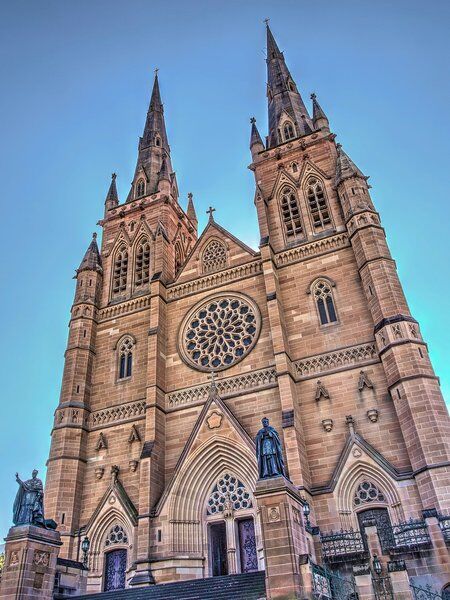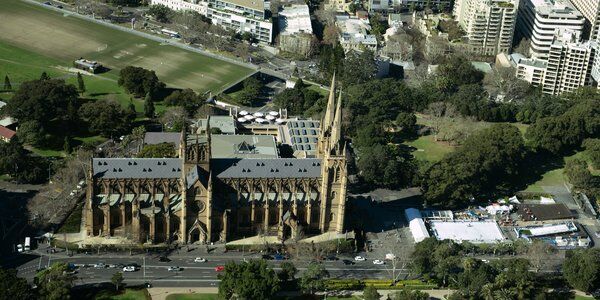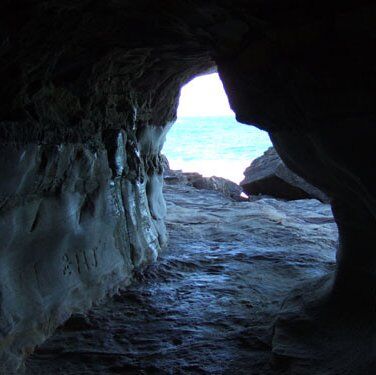Discover St Mary’s Cathedral Sydney
St Mary’s Cathedral is the seat of the Archbishop of Sydney and the principal church of the Roman Catholic Archdiocese of Sydney. It is dedicated to the Immaculate Mother of God, Help of Christians, who is also recognized as the Patroness of Australia.
The cathedral holds the title of a minor basilica, a status it received from Pope Pius XI in 1932 and as of September 2004, holds a prestigious place on the New South Wales State Heritage Register. Its prominent location near the eastern border of Sydney’s central business district (CBD) makes it a significant landmark drawing over 3,000 visitors daily, with its twin spires visible from multiple points across the city.

The History of St Mary’s Cathedral Sydney
Cathedral Origins
St Mary’s Cathedral is located where the first Catholic chapel in Australia was built. The original chapel’s foundation stone was laid in 1821 by Governor Lachlan Macquarie and blessed by Father John Therry, one of the first officially appointed Catholic priests in the colony. This initial chapel was a simple stone structure, constructed in response to the growing Catholic community in Sydney. As the colony expanded, so too did the need for a larger, more permanent place of worship.
The Fire of 1865 and A New Cathedral
The original St Mary’s Cathedral met an unfortunate end in 1865 when it was destroyed by fire. However, this setback paved the way for the construction of the current cathedral. Archbishop John Bede Polding, Sydney’s first Catholic archbishop, commissioned architect William Wardell, to design a new cathedral. Polding gave Wardell complete creative freedom, telling him, “Any plan, any style, anything that is beautiful and grand.”
Wardell’s design was a grand Gothic Revival structure, constructed primarily of dressed Sydney sandstone and inspired by the grand cathedrals of medieval England and France. Wardell’s emphasis on the building’s elongated form is reminiscent of English cathedrals, yet the front façade, with twin towers and a large rose window, evokes the grandeur of French Gothic architecture, particularly Notre Dame de Paris.
Construction and Completion
The construction of the new cathedral took place in two main stages: the first from 1866 to 1900 and the second from 1912 to 1928. Though the cathedral was functional by 1882, it remained incomplete. Archbishop Michael Kelly oversaw the second phase of construction, which included the completion of the south nave.
The final touch to Wardell’s vision came in 2000 when the metal frames for the Southern Spires were placed by helicopter and clad in Gosford sandstone. This marked the completion of a project that had taken over a century.

St Mary’s Cathedral: A Symbol of Faith
St Mary’s Cathedral is not only the largest cathedral in Australia but also a symbol of the resilience and growth of the Catholic Church in the country. Over the years, it has played a central role in key moments in Australian religious history. For instance, the cathedral was the venue for World Youth Day in 2008, an event that attracted global attention and brought Pope Benedict XVI to Sydney.
In 2018, St Mary’s Cathedral celebrated the sesquicentenary (150 years) since the laying of its foundation stone. This milestone was marked by special ceremonies and masses, led by Archbishop Anthony Fisher. The cathedral has also witnessed important national events, including the lying-in-state of Australian Prime Minister Joseph Lyons in 1939.

Key Features of St Mary’s Cathedral Sydney
Here are the most notable aspects of St Mary’s Cathedral:
Layout and Religious Structures
Stepping inside St Mary’s Cathedral reveals an interior equally as breathtaking as its exterior. The nave stretches toward the High Altar, drawing the eye along rows of warm sandstone columns and arched arcades. As with many Gothic cathedrals, St Mary’s interior features a three-tiered layout, including the nave arcade, a gallery-like triforium, and the clerestory, where stained glass windows allow soft, colored light to filter into the sacred space.
The chancel, or sanctuary, at the northern end of the cathedral houses the original High Altar, which is adorned with delicate carvings of alabaster and Oamaru stone. Surrounding the sanctuary are several chapels dedicated to different saints, including the Sacred Heart, St Joseph, and the Blessed Virgin Mary.
Stained Glass Windows and Sculptures
One of the most striking elements of St Mary’s Cathedral is its stained glass windows, particularly the Great North Window. This window casts vibrant colors across the altar, enhancing the spiritual atmosphere within the Cathedral. Each window tells a story, with scenes from the Bible and significant religious figures beautifully illustrated in glass. The intricate stained glass in the sanctuary and transepts depicts the 15 Mysteries of the Rosary, while the north window highlights the Coronation of the Blessed Virgin Mary.
In addition to the stained glass, sculptural details abound both inside and outside the Cathedral. Sculpted saintly heads adorn the stone walls and columns, providing a connection between visitors and the spiritual world. These figures contrast with the grotesque gargoyles perched high on the towers. Inside the Cathedral, the chapels that line the nave are notable for their elaborate ceilings, while the baptistery features a stunning "Royal Sienna" marble font.

The Crypt
Beneath the main Cathedral lies the crypt, a peaceful and sacred space. The crypt’s floor is a magnificent mosaic of terrazzo, designed with medieval European artistry in mind. It serves as the final resting place for several Archbishops of Sydney and prominent clergy, including Fr John Joseph Therry, the founder of the Cathedral.
The Bells of St Mary’s Cathedral
Housed in Cardinal Moran’s Tower, the Cathedral’s bells have been a part of Sydney’s soundscape since 1843. Cast by the Whitechapel Bell Foundry in London, the peal consists of twelve bells, with two additional bells for special ringing arrangements. These bells ring out for Sunday services, feast days, and special occasions, playing a key role in significant civic events such as the centenary of the Australian Federation.
Musical Heritage and Organs
St Mary’s Cathedral is not only a place of worship but of music. Its grand organ, crafted by Orgues Létourneau, is a central feature of the Cathedral’s music program. Completed in 1999, this grand instrument fills the space with resonant sound, enhancing both liturgical services and concert performances.
Additionally, the Cathedral is home to the oldest continuous musical institution in Australia, its choir, which performs Gregorian chants, sacred polyphony, and contemporary compositions, offering visitors a deeply moving auditory experience.

Art and Religious Treasures
The Cathedral’s interior is rich with religious art and artifacts. The 14 large oil paintings of the Stations of the Cross, selected by Cardinal Moran in the 19th century, depict key moments in Christ’s Passion and line the aisles near the sanctuary. Each of these works is designed to prompt deep reflection, inviting visitors and worshippers alike to contemplate the events of the Passion.
In the western transept, a marble replica of Michelangelo's Pietà stands as a focal point. Originally brought to Australia for display in a department store, this sculpture was later donated to the Cathedral, becoming one of its most cherished features. Another significant piece is George Washington Lambert’s Grave of the Unknown Soldier, a life-size sculpture that was once housed in the crypt but is now displayed in the main aisle to allow greater access for visitors.
The Spires
The cathedral’s prominent spires, completed in 2000, now reach a height of 75 meters, further enhancing its impressive silhouette against the Sydney skyline. The addition of these spires 132 years after construction first began elevated St Mary’s Cathedral to new heights—both literally and figuratively—making it one of the tallest churches in Australia. The flight of over 30 steps leading up to the main entrance was added to accommodate the site’s natural slope, creating a ceremonial approach that enhances the grandeur of the façade.
The Mosaic Floor
Beneath the Cathedral lies one of its most breathtaking artistic features: a mosaic floor designed by Peter Melocco. The intricate cross-shaped design mirrors the illuminated manuscripts of Celtic tradition, with rondels depicting the Days of Creation and titles of the Virgin Mary. This mosaic is often considered the most beautiful flooring in the world.

Visiting St Mary’s Cathedral Sydney
Opening Hours and Guided Tours
St Mary’s Cathedral welcomes visitors daily, with opening hours from 6:30 am to 6:30 pm during the week and slightly extended hours on weekends. Admission is free, but donations are always appreciated. While the Crypt is temporarily closed to the public, there is still much to explore within the Cathedral’s main halls.
Visitors interested in learning more about the Cathedral’s history and architecture can take advantage of the free guided tours offered every Sunday at 2:00 pm. For those interested in a more personalized experience, weekday group tours are available upon request for a small fee, though these must be booked in advance due to the Cathedral’s busy schedule.
Getting to St Mary’s Cathedral
St Mary’s Cathedral is conveniently located at the corner of College Street and St Mary’s Road, right across from Hyde Park and the Hyde Park Barracks in central Sydney. Its proximity to major public transportation hubs makes it easily reachable.
For those using public transportation, the nearest train stations are St James, Museum, and Town Hall, all of which are a short 7-minute walk from the Cathedral. If you're arriving by bus, simply disembark near Hyde Park or Town Hall and head east along Park Street.
While there is no onsite parking at the Cathedral, visitors can find metered parking nearby or utilize public parking facilities like the Domain Car Park, located just across the road, and the Enacon Parking under the Cathedral steps.

Tips for Visitors
St Mary’s Cathedral is not just a historic site, but an active place of worship, so visitors are encouraged to be respectful.
- Talking in hushed tones is advised to avoid disturbing worshipers, and mobile phones should be kept silent.
- Gentlemen are asked to remove their hats upon entry, and all visitors should dress modestly—covering shoulders and avoiding short skirts or bare feet.
- While photography is permitted, visitors are asked to refrain from taking pictures during Mass or other religious celebrations. Additionally, flash photography is discouraged.

Explore Beyond St Mary’s Cathedral Sydney with CityDays
If you want to discover other historical sites around the CBD—with rest stops at cafes and bars along the way—why not embark on a CityDays Scavenger Hunt in Sydney, and in particular our Secrets of the CBD Hunt?
Scavenger Hunt tours are a great way to bring family and friends—or even dates—together for an afternoon of great fun and adventure, solving clues and snapping photos. Clues will lead you to the big sights and those that you'd walk straight past.
Our Secrets of the CBD Hunt is the perfect way to experience the city, and culminates at the historic Rocks. For more information about our Sydney Scavenger Hunts then click here: Sydney Scavenger & Treasure Hunts | CityDays.
















